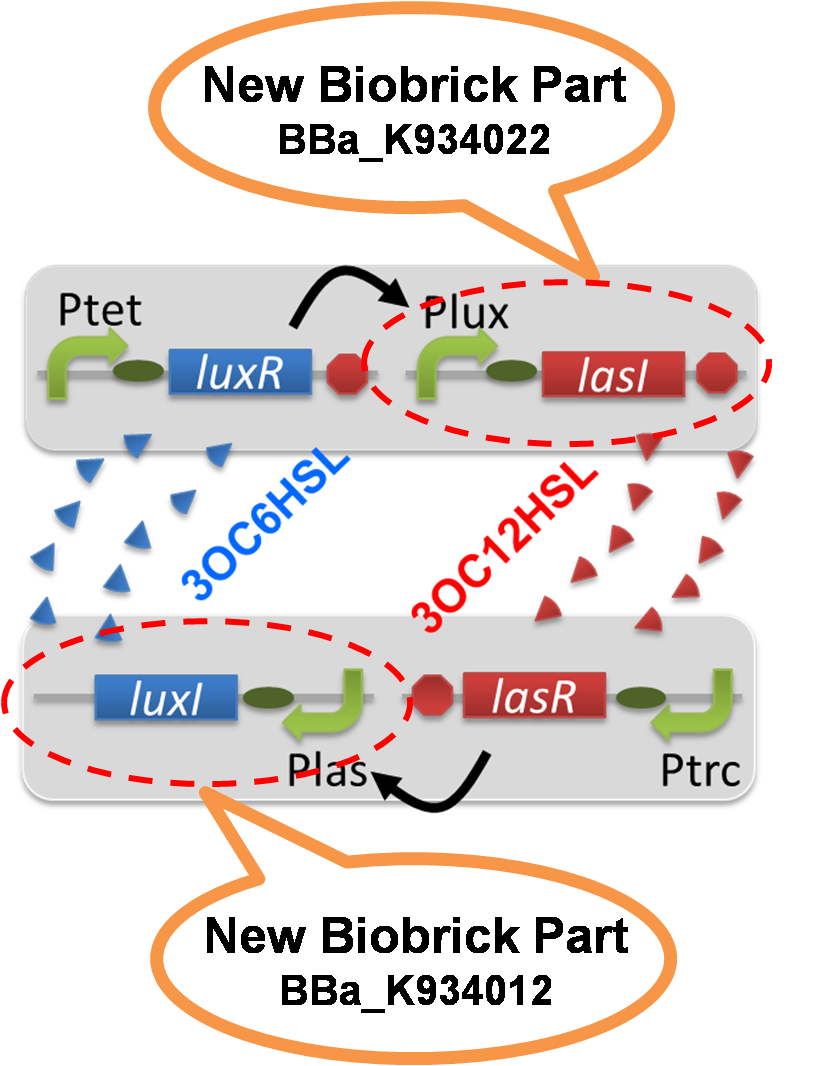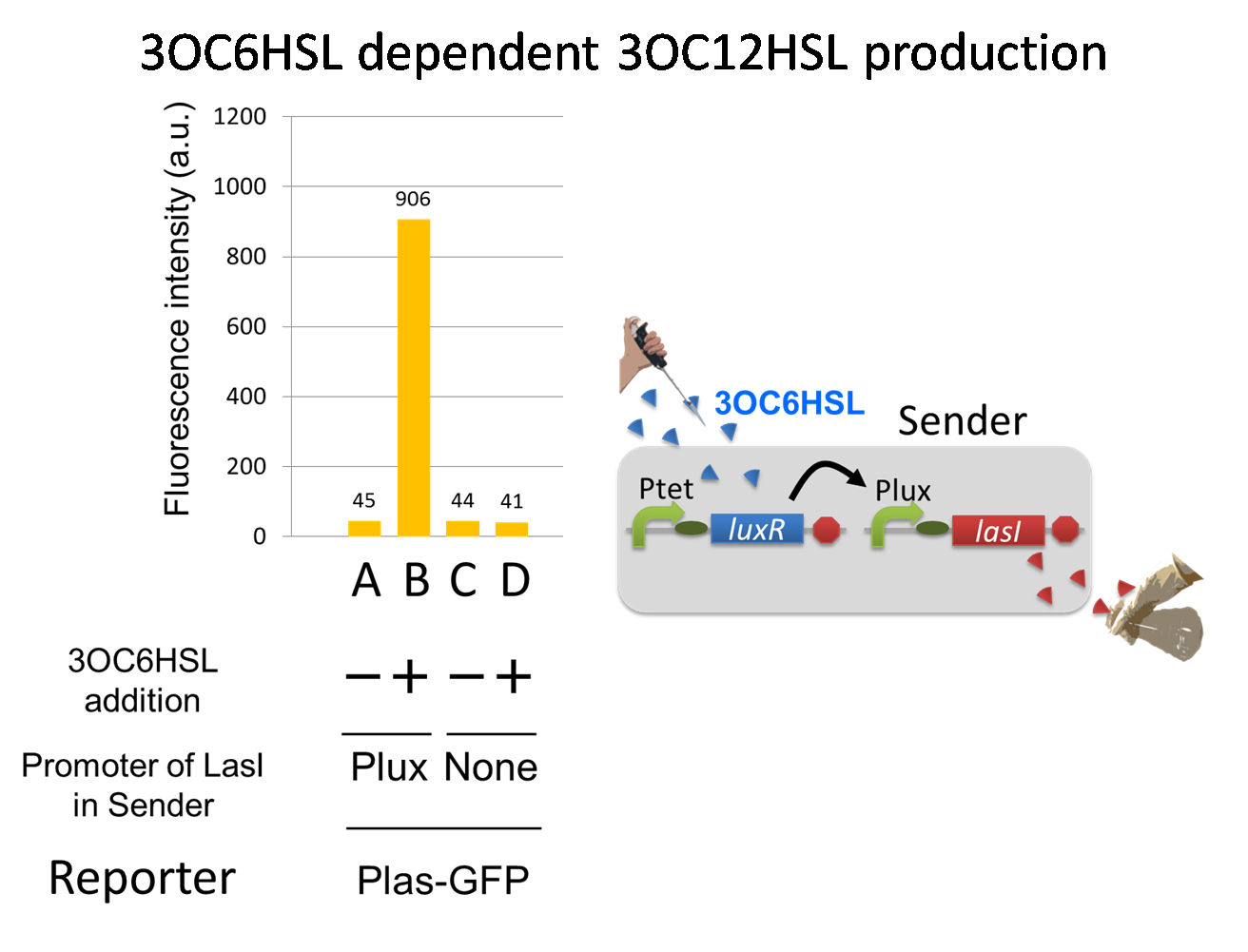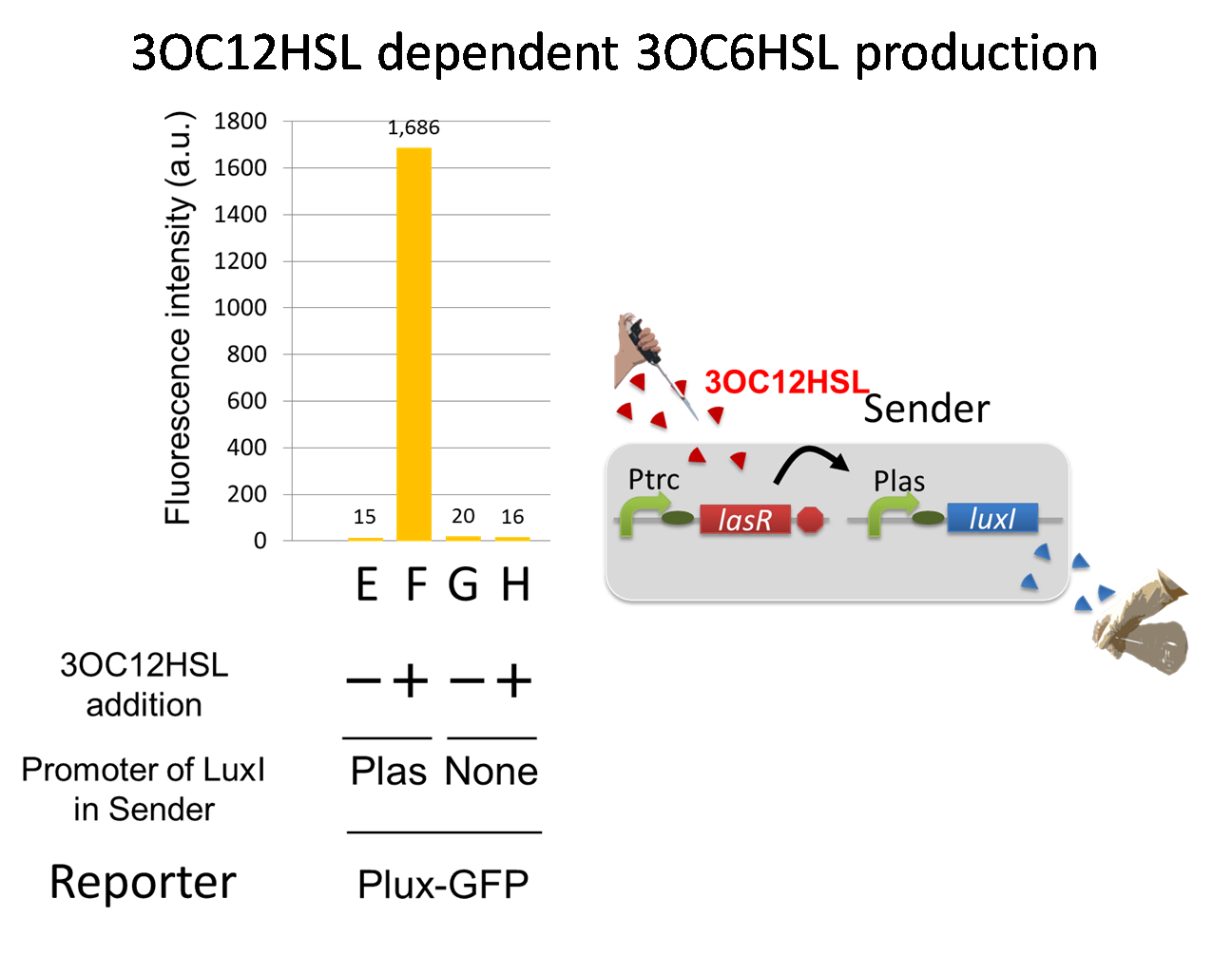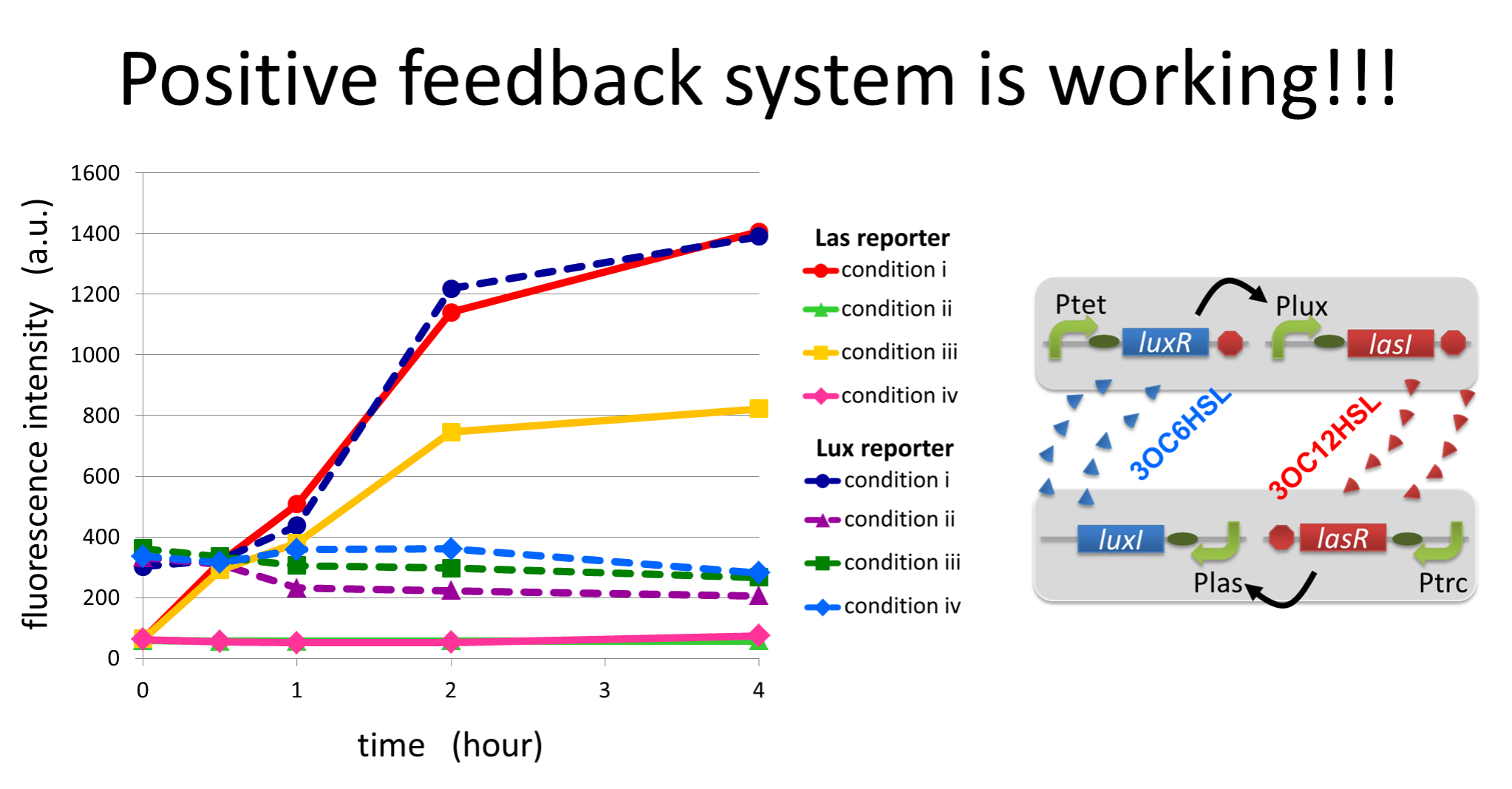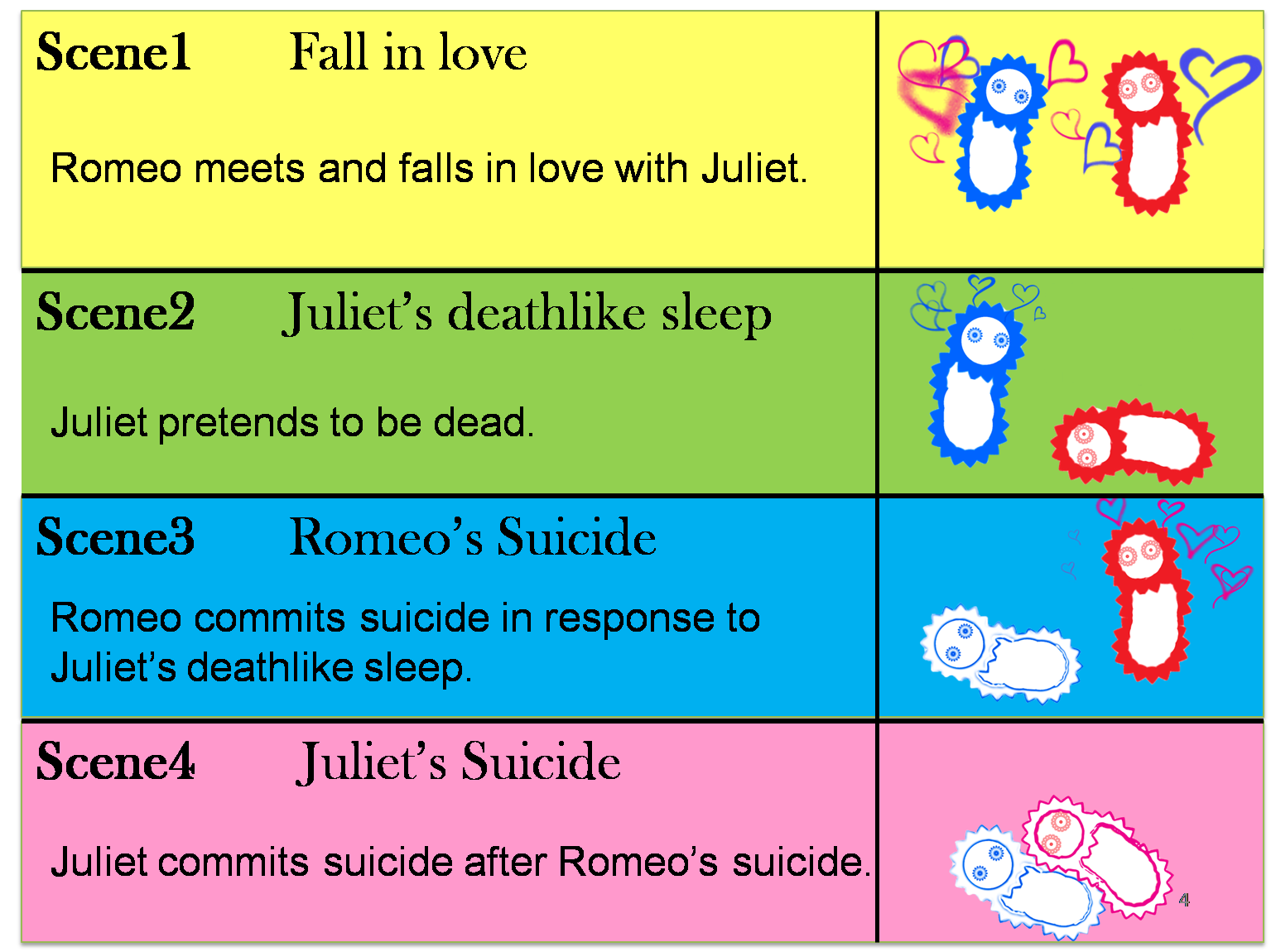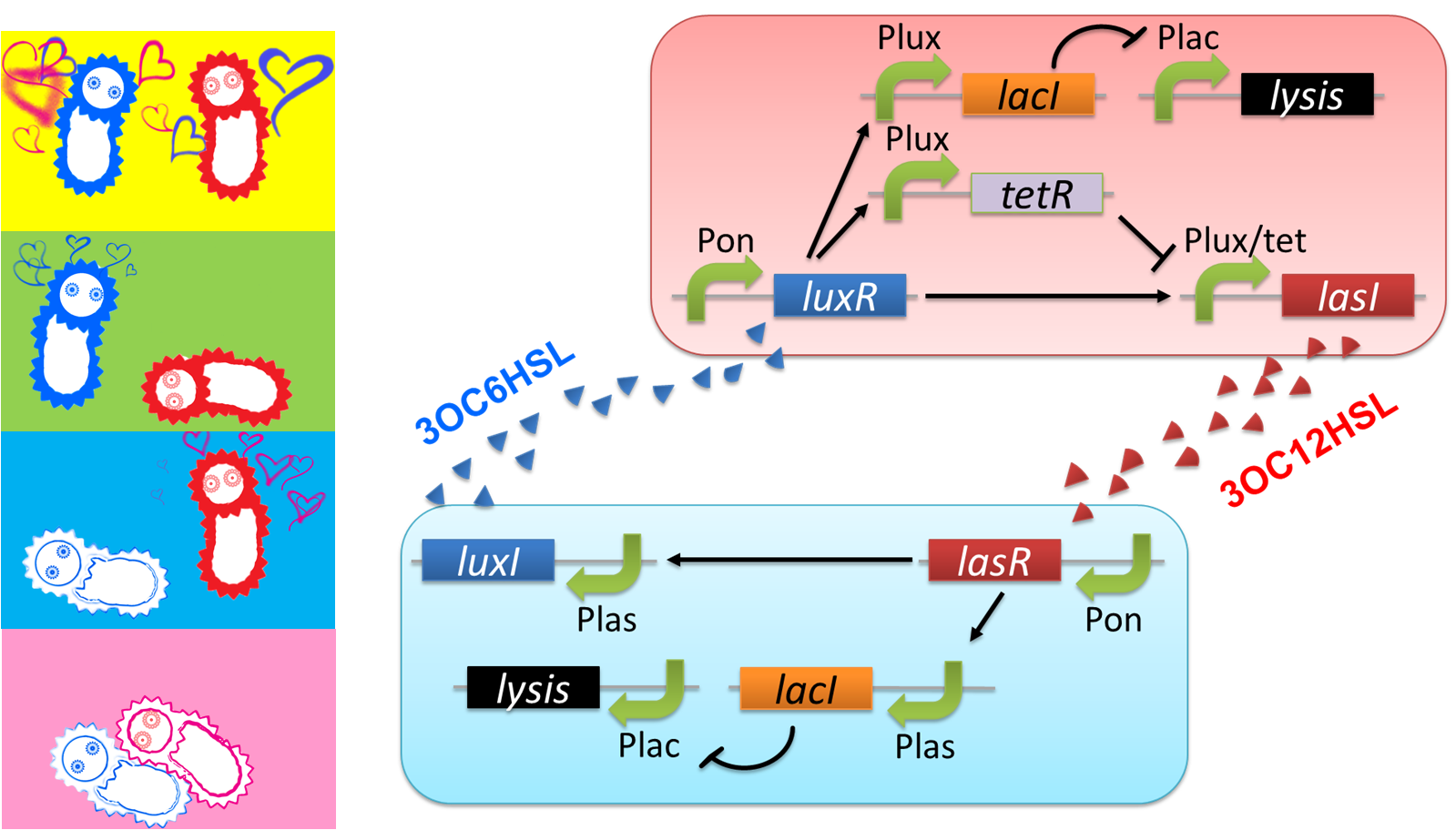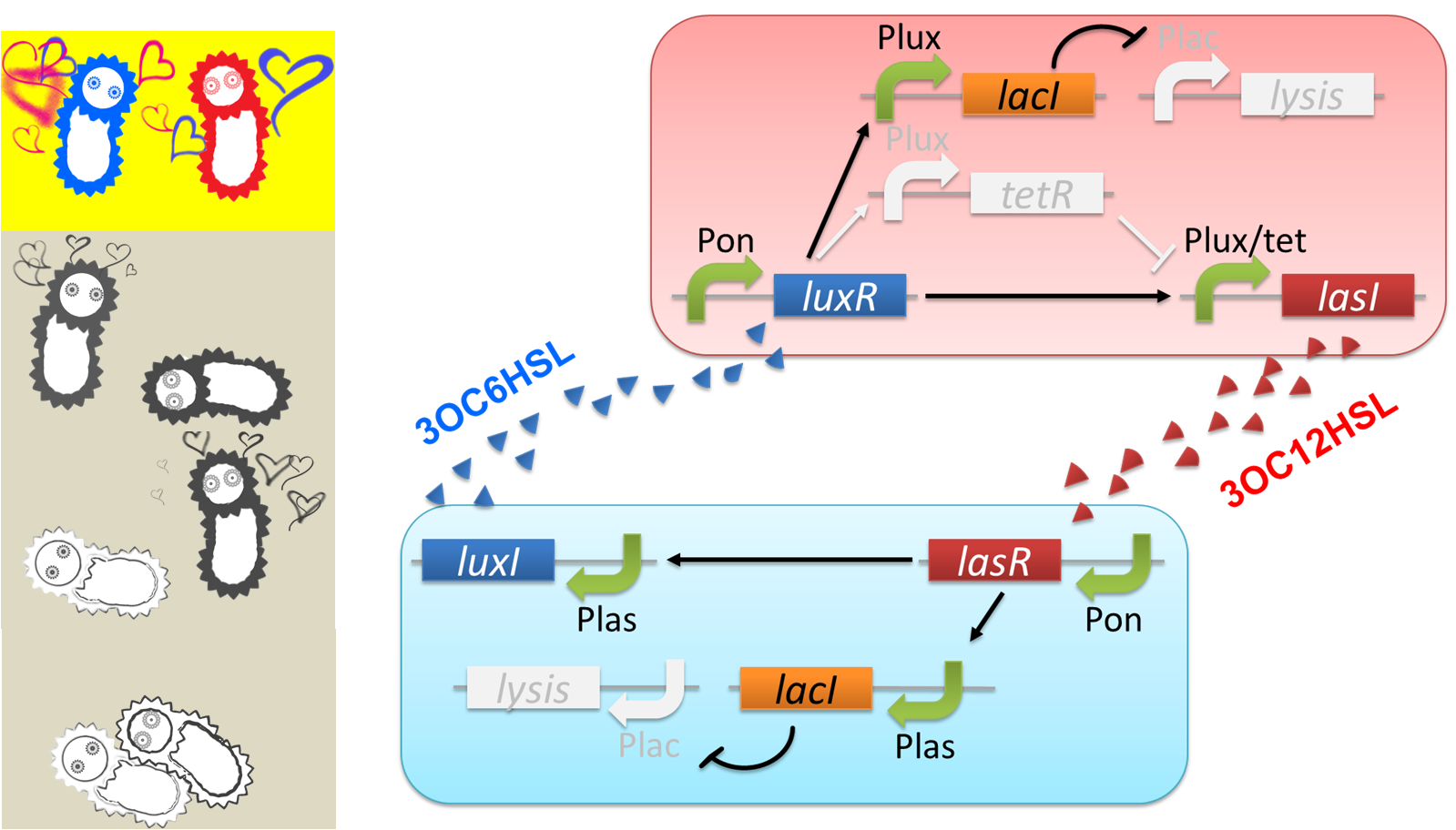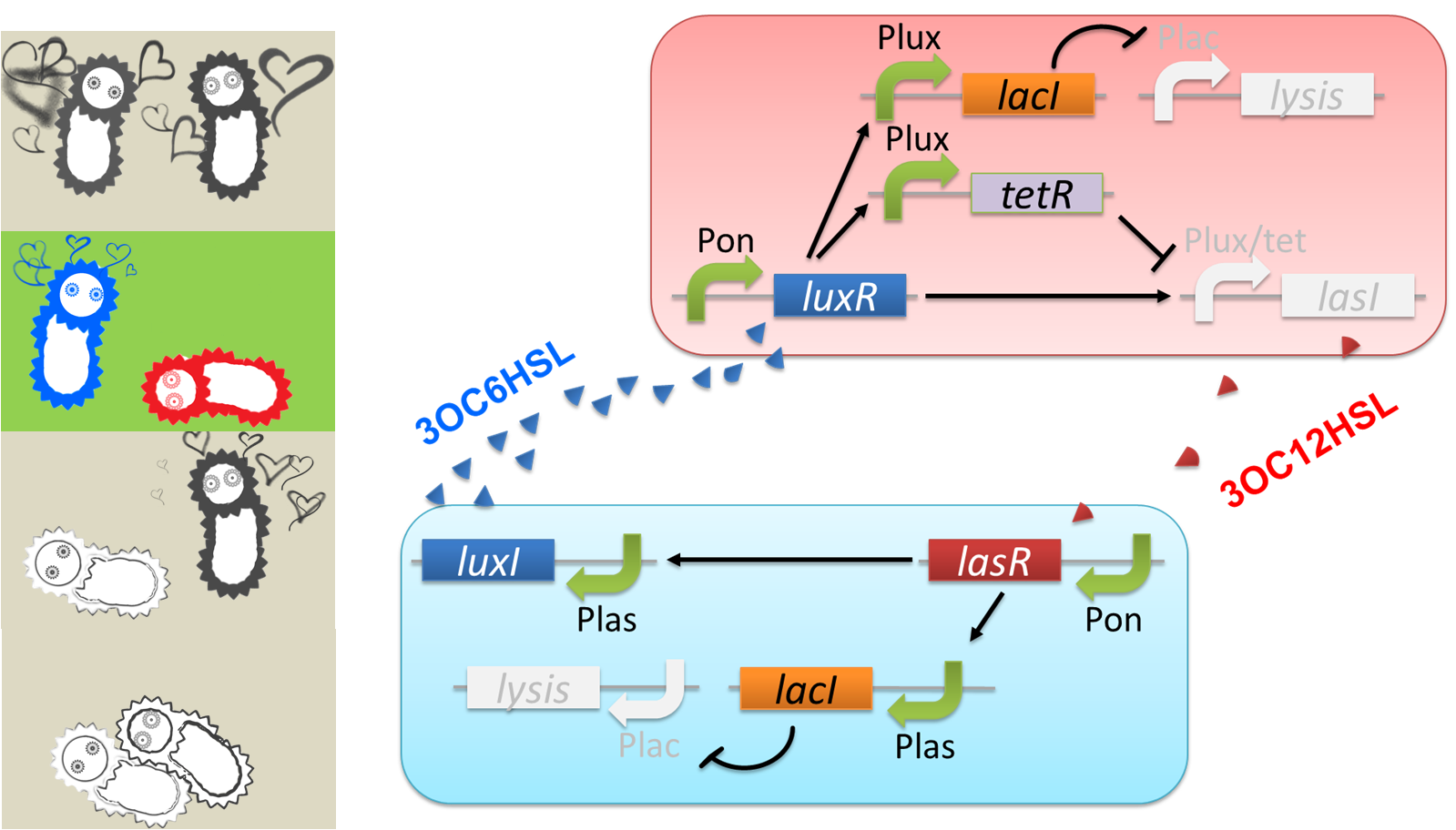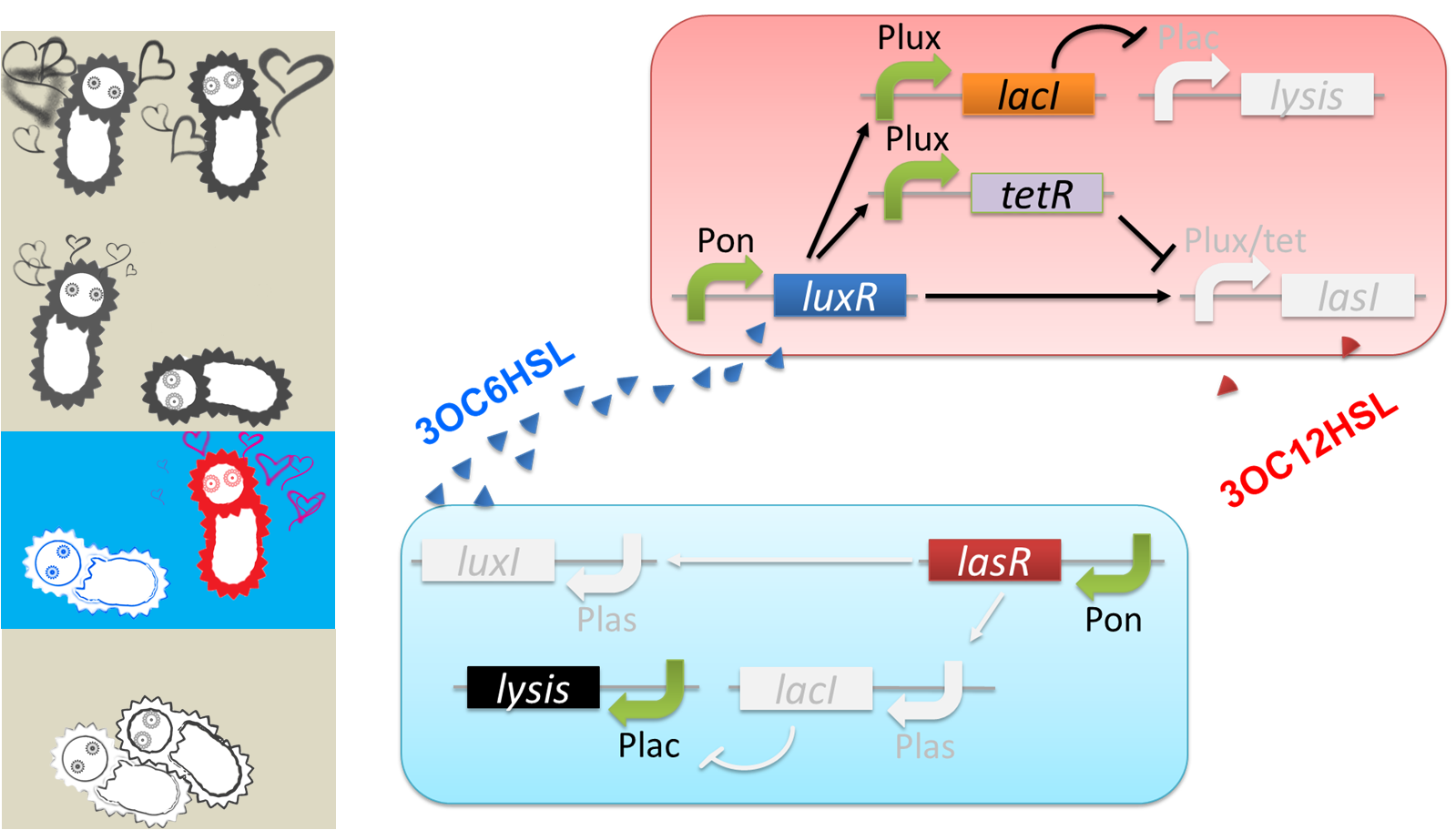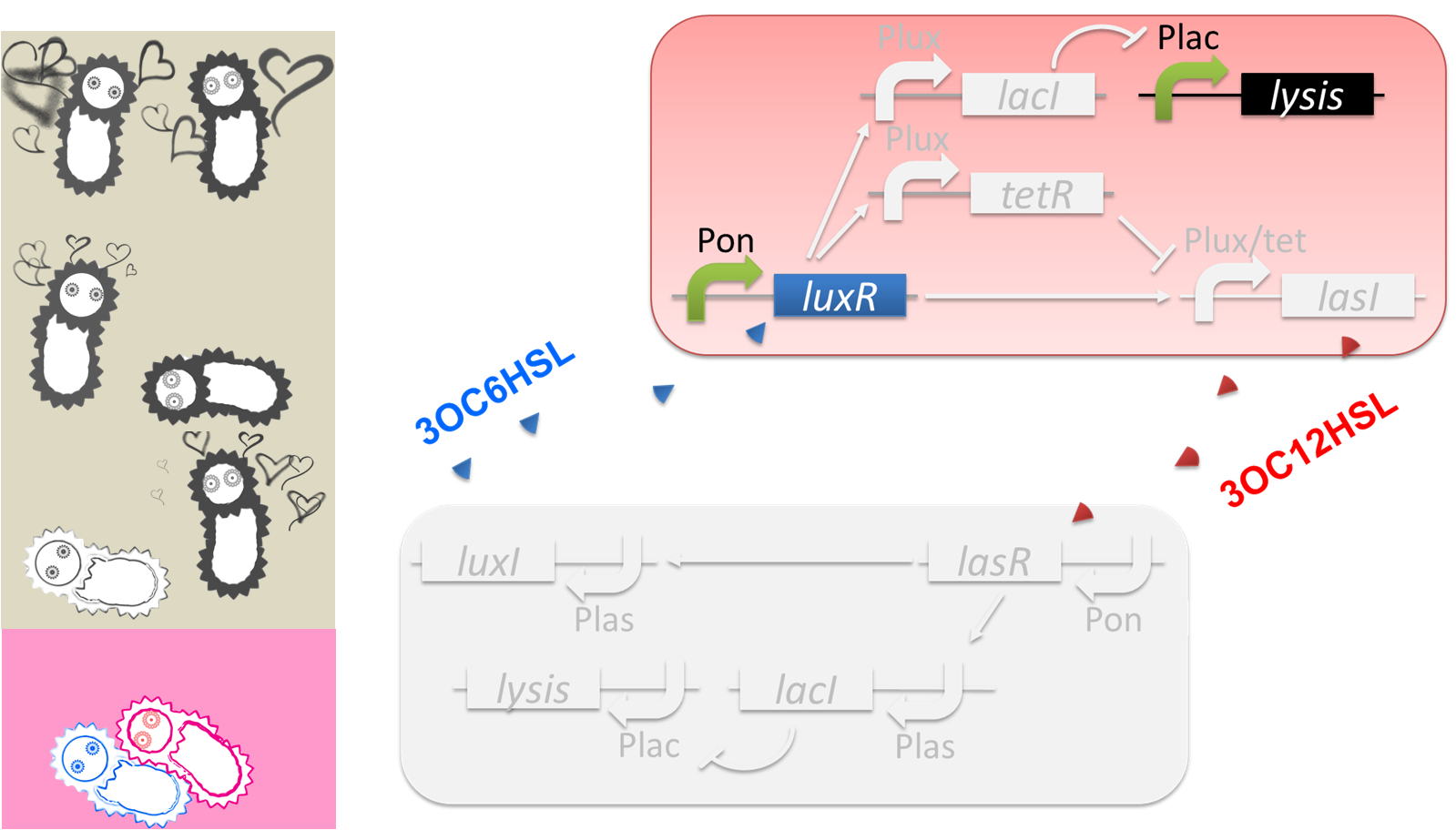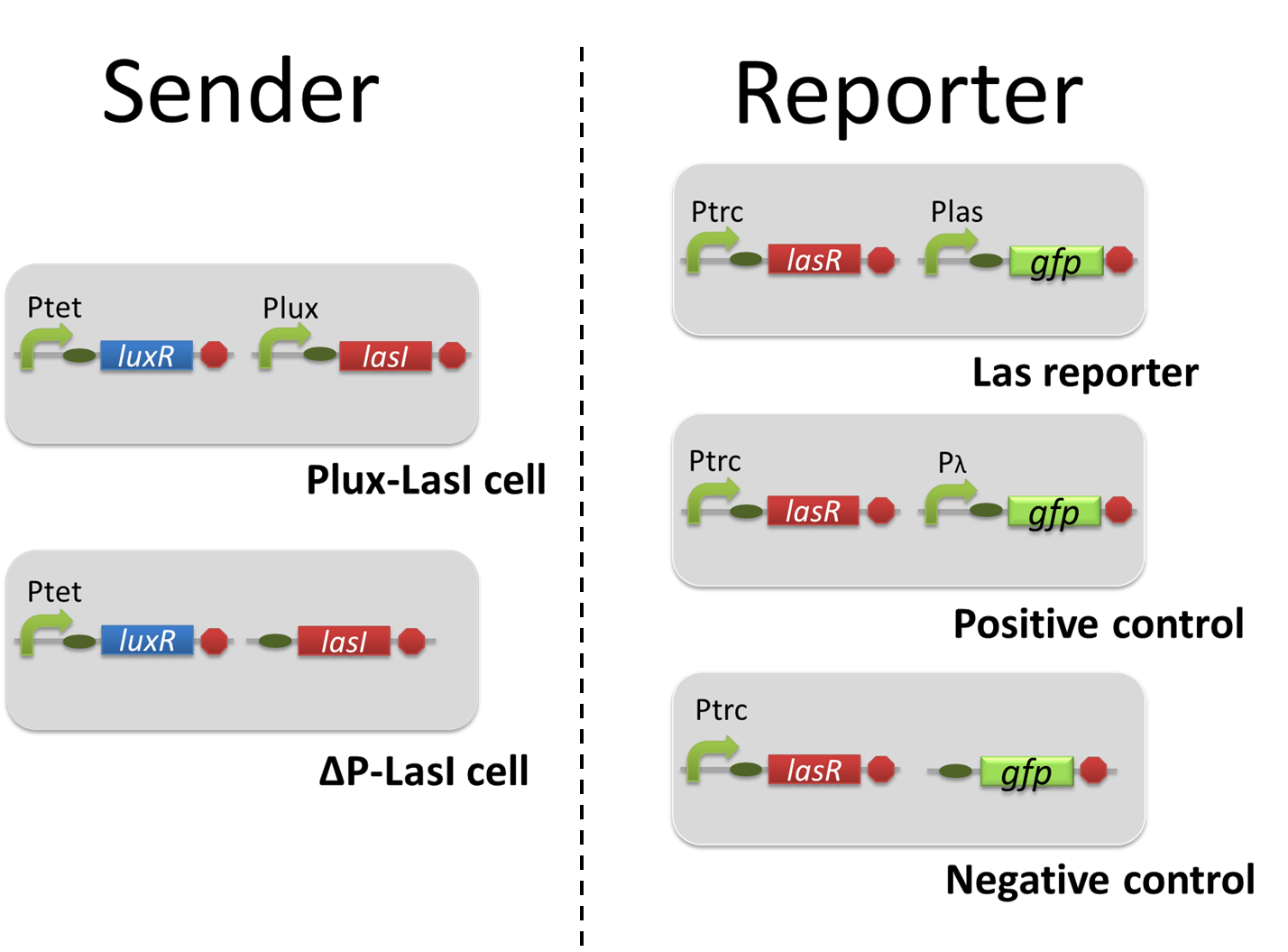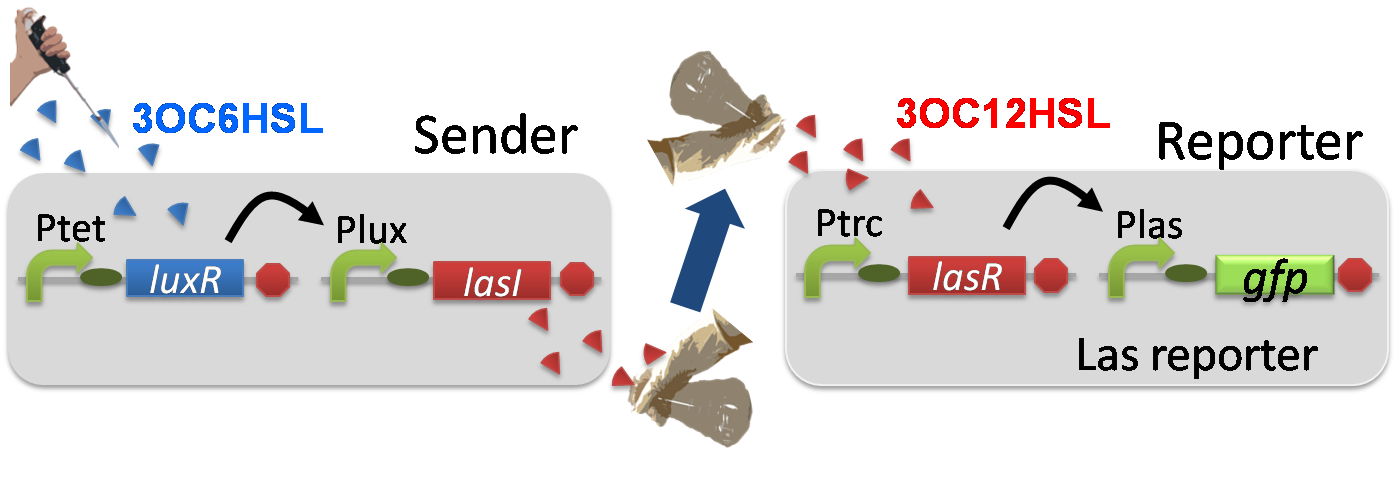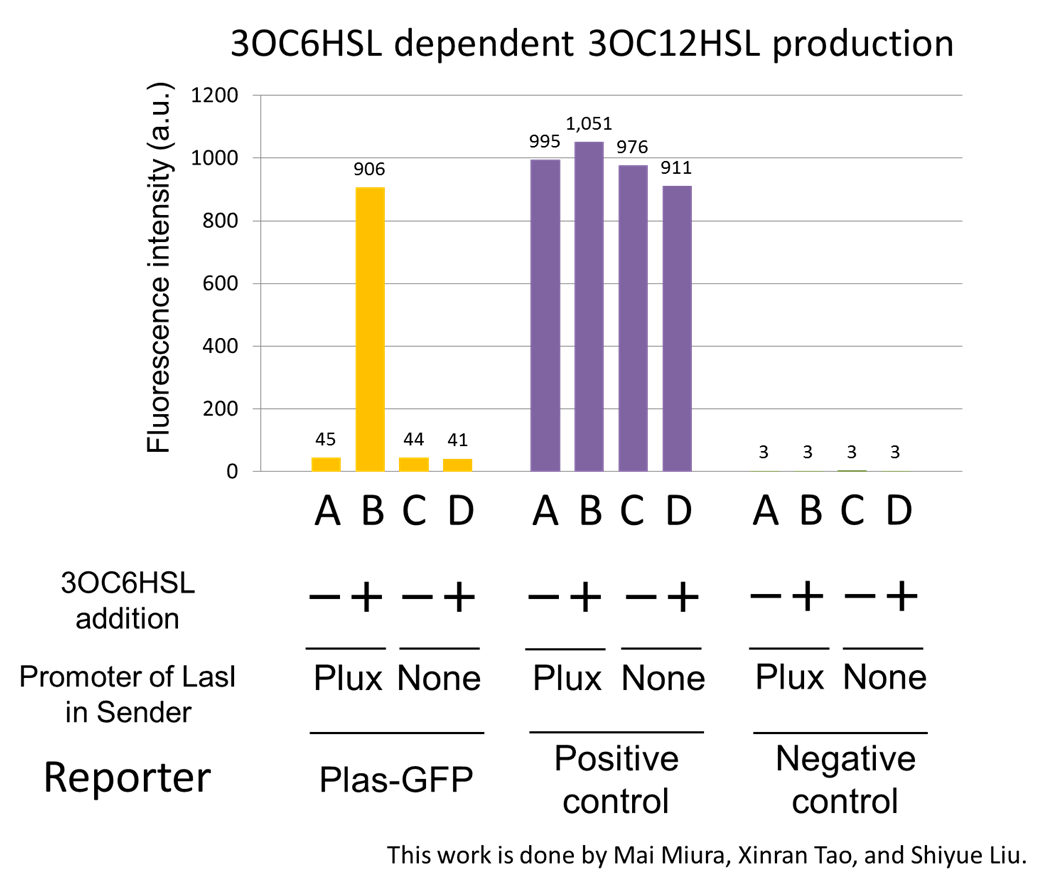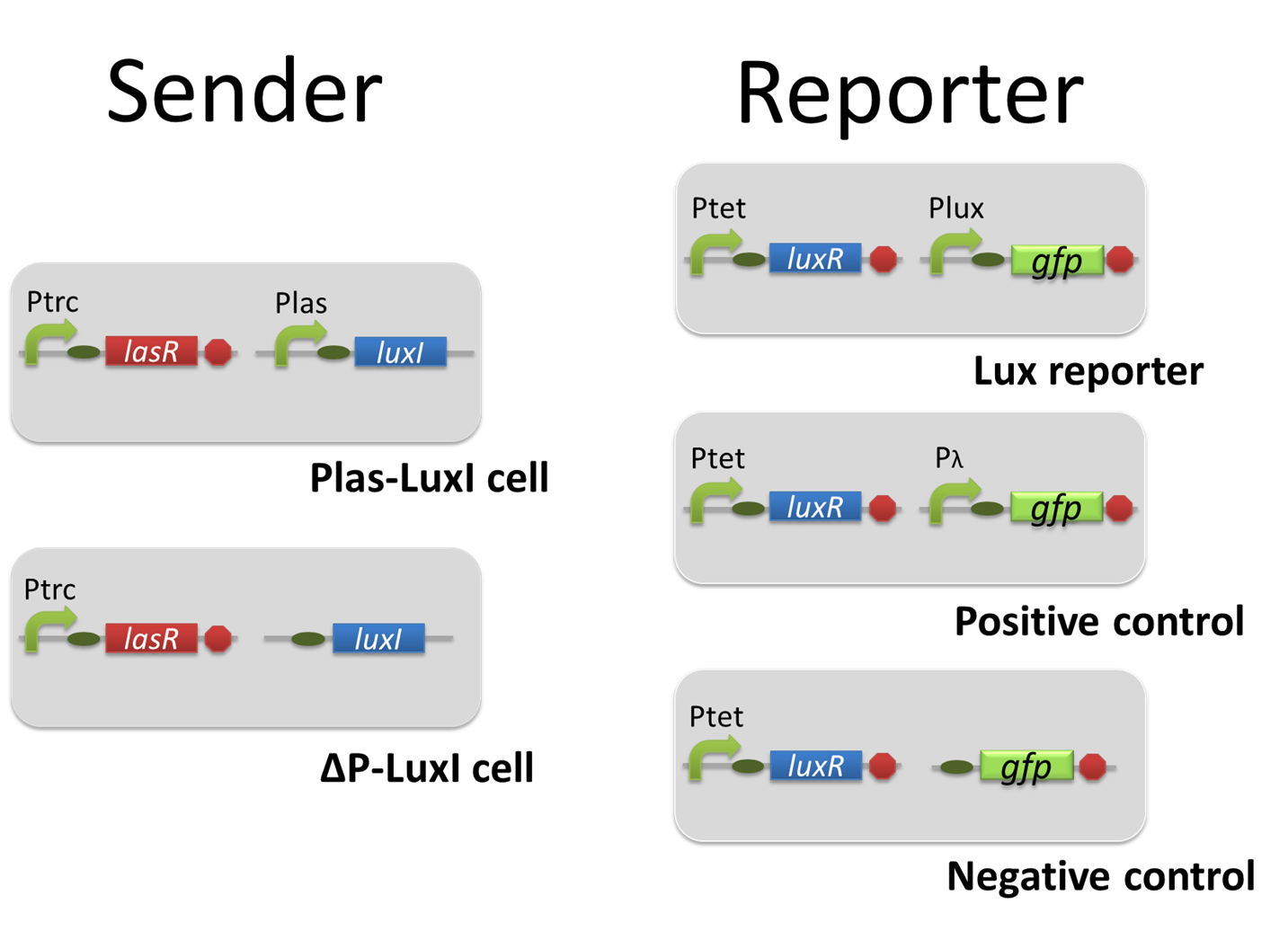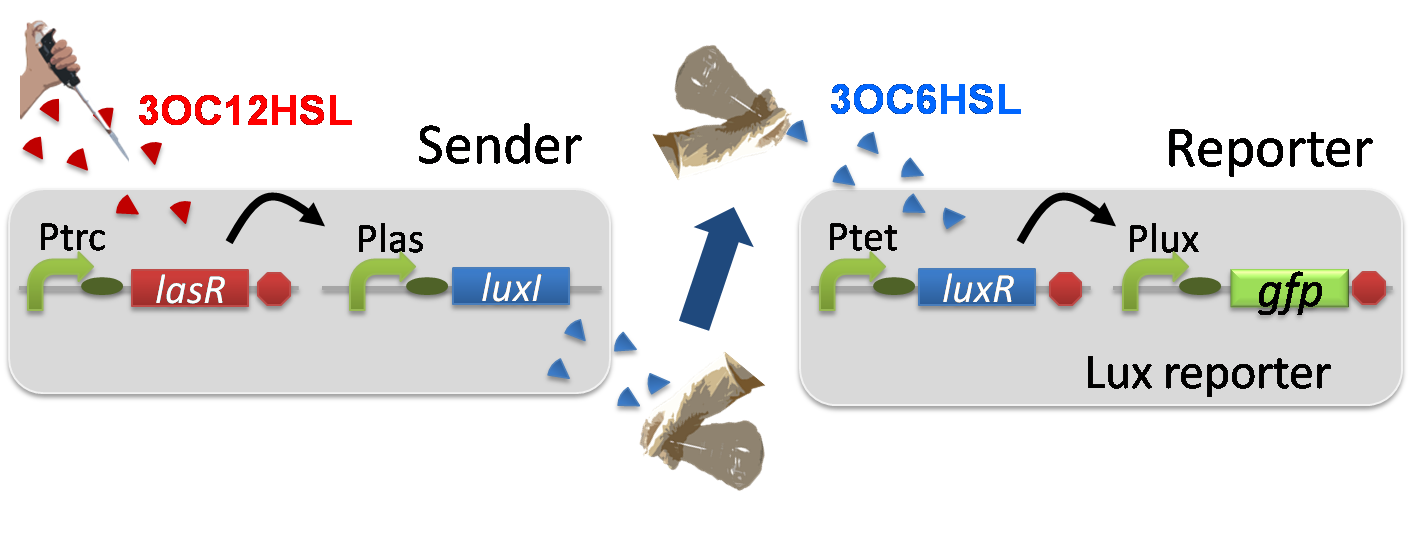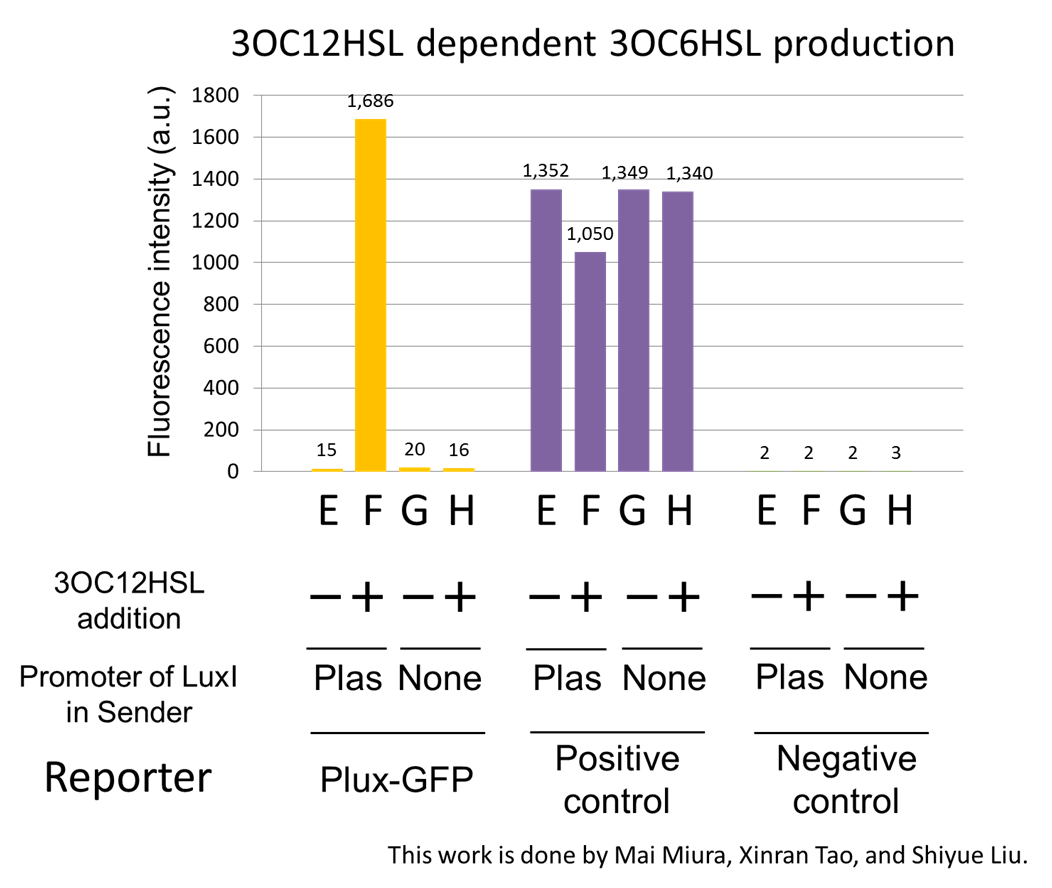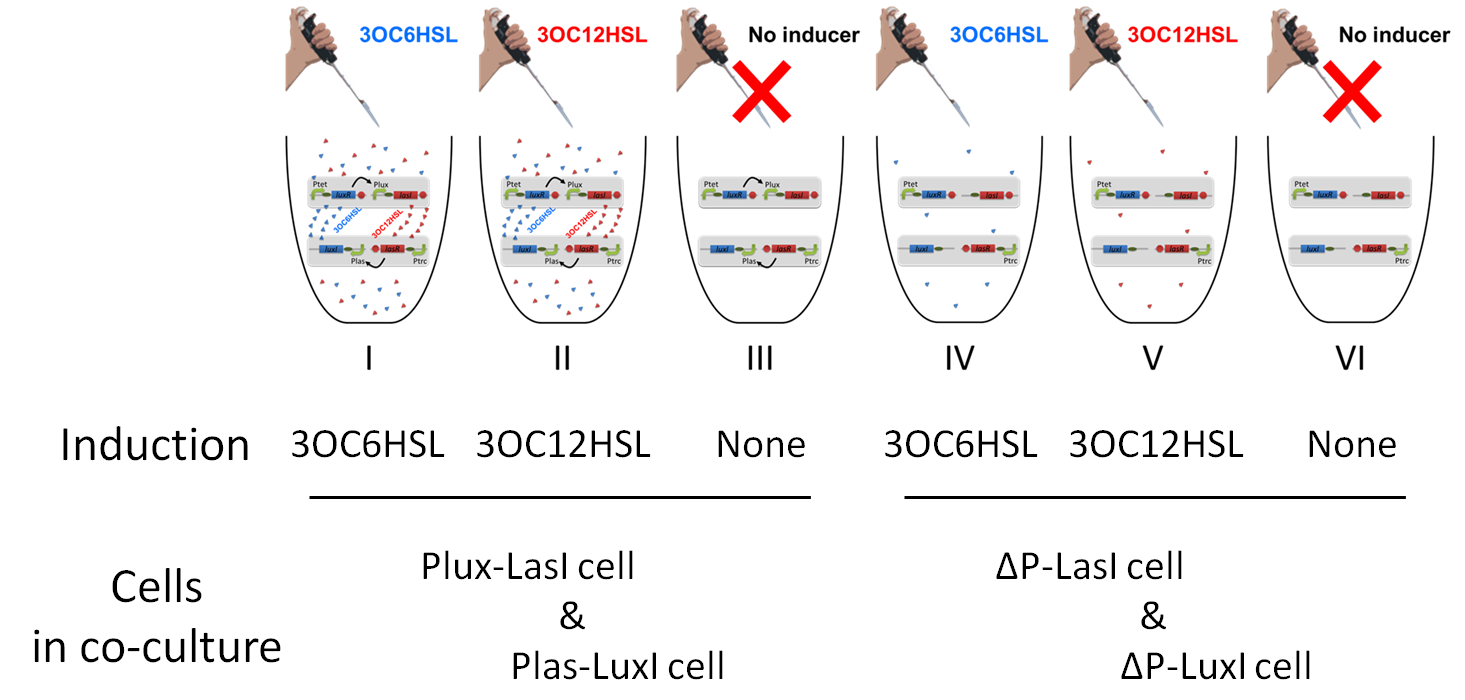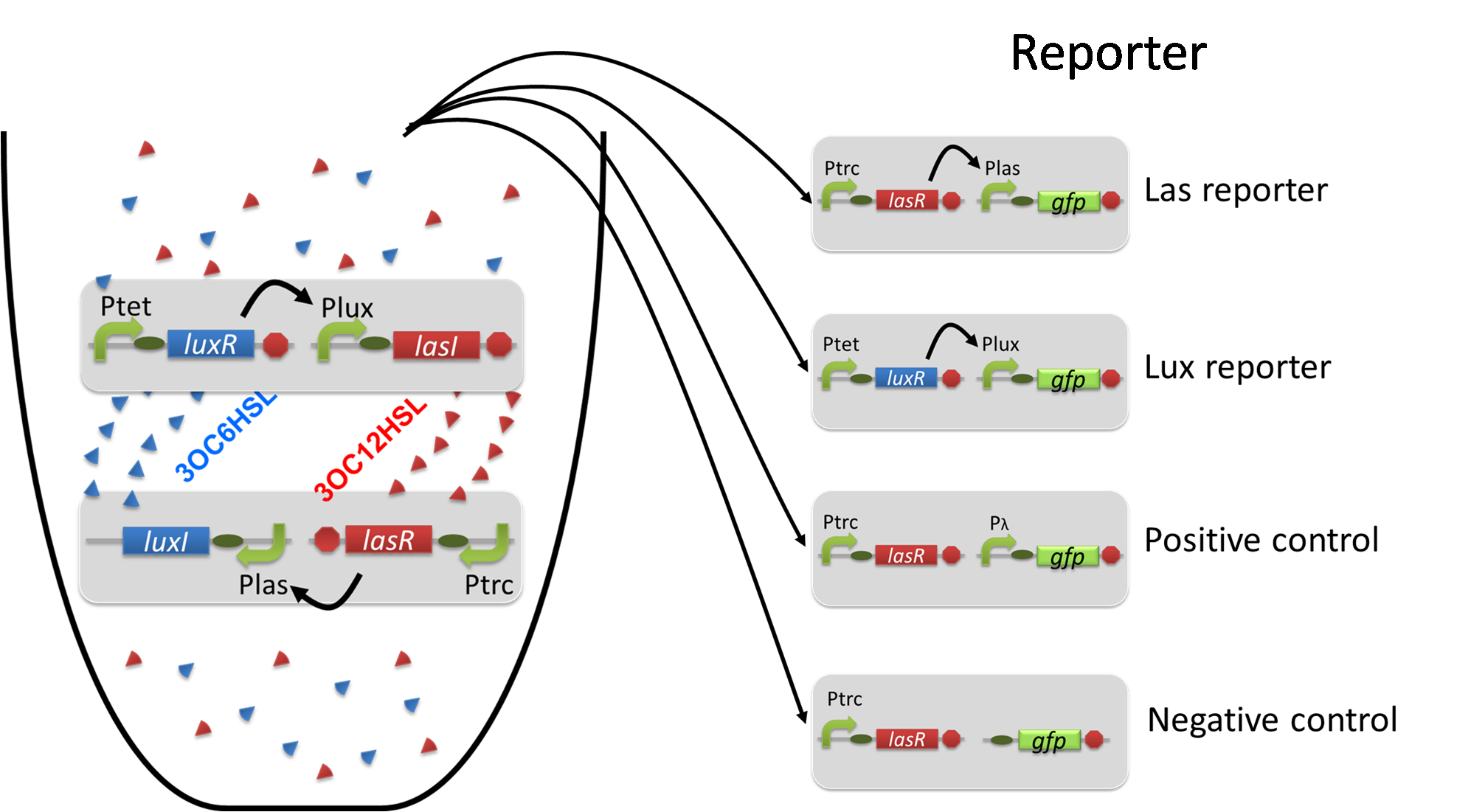Team:Tokyo Tech/Project
From 2012.igem.org
(→Construction of the positive feedback system) |
(→Construction of the positive feedback system) |
||
| Line 143: | Line 143: | ||
==Construction of the positive feedback system== | ==Construction of the positive feedback system== | ||
[[File:positivefeedbackassay27tokyotech.png|300px|thumb|right|positivefeedbackassay27]] | [[File:positivefeedbackassay27tokyotech.png|300px|thumb|right|positivefeedbackassay27]] | ||
| - | [[File:positivefeedbackassay28tokyotech.png| | + | [[File:positivefeedbackassay28tokyotech.png|250px|thumb|right|positivefeedbackassay28]] |
To accomplish complete positive feedback system, we mixed and co-cultured Plux-LasI cell and Plas-LuxI cell. As a control co-culture, ⊿P-LasI cell and⊿P-LuxI cell were mixed. As a trigger of the positive feedback system, we added 3OC6HSL ( nM) or 3OC12HSL ( nM) to co-culture. With no-induction control, we thus prepared six conditions (Fig ). To confirm that both 3OC6HSL and 3OC12HSL are produced in the positive feedback, HSLs content in the supernatant of the co-culture were evaluated by Las reporter strain and Lux reporter strain. | To accomplish complete positive feedback system, we mixed and co-cultured Plux-LasI cell and Plas-LuxI cell. As a control co-culture, ⊿P-LasI cell and⊿P-LuxI cell were mixed. As a trigger of the positive feedback system, we added 3OC6HSL ( nM) or 3OC12HSL ( nM) to co-culture. With no-induction control, we thus prepared six conditions (Fig ). To confirm that both 3OC6HSL and 3OC12HSL are produced in the positive feedback, HSLs content in the supernatant of the co-culture were evaluated by Las reporter strain and Lux reporter strain. | ||
Revision as of 20:49, 24 September 2012
Contents |
Abstract
We designed a cell-cell communication system that makes two types of engineered E.coli play “Romeo and Juliet”. We represented the four scenes with concentration of signal molecules 3OC6HSL and 3OC12HSL. 3OC6HSL is synthesized by LuxI enzyme in cell Romeo, and 3OC12HSL is synthesized by LasI enzyme in Juliet cell. To reproduce the four scenes, we designed three subsystems: positive feedback system, band detect system, and communication-inverter dependent suicide system.
First, we achieved complete positive feedback system for “Scene1 Fall in love” by construction and characterization of two important parts: Plux-LasI and Plas-LuxI. We confirmed that 3OC6HSL-dependent 3OC12HSL producer cell synthesized enough concentration of 3OC12HSL to induce the Las reporter. In the presence of 3OC6HSL, the fluorescence intensity of Las reporter became 42 times stronger than that of Las reporter in the absence of 3OC6HSL (fig.X). We also confirmed that 3OC12HSL-dependent 3OC6HSL producer cell synthesized enough concentration of 3OC6HSL to induce the Lux reporter. In the presence of 3OC12HSL, the fluorescence intensity of Las reporter became 116 times stronger than that of Las reporter in the absence of 3OC12HSL. (fig.XX). Then, to accomplish the complete positive feedback system, we confirmed that the production of a signal activates the production of the other signal, when both type of cell coexist. GFP was expressed in both Las reporter and Lux reporter only when the supernatant of co-culture in which both 3OC12HSL dependent 3OC6HSL producer cell and 3OC6HSL dependent 3OC12HSL producer cell were contained was used as inducer (fig. XXX).
Second, to accomplish the 3OC6HSL-dependent band detect system for “Scene2 Juliet’s deathlike sleep”, we characterized Lux/Tet hybrid promoter which is important part for our band detect system. Plux/tet-GFP expressed fluorescence only in the presence of both 3OC6HSL and aTc. In this situation, the fluorescence intensity became 521 times than that in the absence of both inducers (figxxxx).
Third, to represent “Scene3 Romeo’s suicide” and “Scene4 Juliet’s suicide”, we constructed two communication inverters: Plux-LacI and Plas-LacI. Plux-LacI expresses LacI repressor in the presence of 3OC6HSL. On the other hand, Plas-LacI expresses LacI repressor in the presence of 3OC12HSL.
Story
We make our cute E.coli play “Romeo and Juliet” which is one of Shakespeare’s most famous plays. In this project, we define the signal that E.coli produce as the romantic feeling of Romeo and Juliet. In this project, we will recreate the love story of "Romeo&Juliette", by using "Cell-cell communication"
The story that we reproduce is divided into four scenes.
(Scene 1) Romeo and Juliet encountered and they fell in love with each other.
(Scene 2) However, providence lane person, this period of pure love might never broom since they were born in two feuding families. In order to keep their relationship, Juliet planned to pretend die by drinking the drug that will put her into a death like coma so that when she woke up there will be no obstacle between their great loves.
(Scene 3) However, this new was not conveyed to Romeo in time. Romeo misunderstood Juliet’s death and committed suicide.
(Scene 4) When Juliet woke up, what waiting for her was not a beautiful future but Romeo’s death that is waiting for her. Juliet felt so sad and she followed Romeo by stabbing herself with a dirk.
Design of genetic circuit
| video1 Behavior of our circuit for “Romeo and Juliet” |
Pon: promoter which is turned on.
Plux: promoter activated by LuxR/3OC6HSL complex.
Plas: promoter activated by LasR/3OC12HSL complex.
Plac: promoter repressed by LacI.
Plux/tet: hybrid promoter activated by LuxR/3OC6HSL complex and repressed by TetR
We designed a cell-cell communication system that makes two types of engineered E.coli play “Romeo and Juliet”. We represented the story with concentration of signal molecules 3OC6HSL and 3OC12HSL. 3OC6HSL is synthesized by LuxI in Romeo cell, and 3OC12HSL is synthesized by LasI in Juliet cell. To reproduce the four scenes, we designed three subsystems.
First, to represent “Scene1 Fall in love”, we designed a positive feedback system in which the production of a signal activates the production of the other signal.
Second, we applied a 3OC6HSL-dependent band detect system to represent “Scene2 Juliet’s deathlike sleep” by a stop of 3OC12HSL production. When the concentration of 3OC6HSL reaches higher level by the positive feedback, the concentration of TetR is enough level to repress the expression of LasI, and the production of 3OC12HSL is stopped.
Third, to realize “Scene3 Romeo’s suicide” in response to Juliet’s deathlike sleep, we designed 3OC12HSL dependent LacI inverter. When Juliet cell is in deathlike sleep, supply of 3OC12HSL is stopped. In the absence of 3OC12HSL, the lysis gene is expressed and Romeo cell dies.
Finally, to realize “Scene4 Juliet’s suicide” in response to Romeo’s suicide, we also designed 3OC6HSL dependent LacI inverter. After the death of Romeo cell, supply of 3OC6HSL is stopped, and the expression of LacI is stopped. As a result, the lysis gene is expressed and Juliet cell dies.
The love between Romeo and Juliet is realized by positive feedback of cell-cell communication signals (fig2). In our positive feedback system, two types of E.coli communicate and regulate each other’s production of signal. An increase of one signal causes the increase of the other signal production, resulting in the increase of the signal itself. For the positive feedback system, two quorum sensing modules, LuxI/LuxR and LasI/LasR, which enable two-way communication, were used. Juliet cell expresses LuxR, which is a 3OC6HSL-dependent transcriptional regulator, constitutively. While Romeo cell expresses LasR, which is a 3OC12HSL-dependent transcriptional regulator constitutively. In cell Juliet, LuxR bound with signal 3OC6HSL, and LuxR/3OC6HSL complex activates the expression of LasI. In the mean time, 3OC12HSL produced in Juliet cell is bound by LasR. LasR/3OC12HSL complex activates the expression of LuxI. LuxI and LasI are signal synthesizing enzymes, so the concentration of signal molecules becomes higher when the transcription of LuxI and LasI is activated. The higher concentration of signal molecules, the more complexes exist in each cell, and the activation of signal senders gets stronger. As a result, the increase of the signal synthesis is accelerated.
The “Juliet’s deathlike sleep” that is represented by the stop of 3OC12HSL production is realized by 3OC6HSL-dependent band detect system (fig3). The band detect system is composed of TetR whose expression is regulated by LuxR-3OC6HSL complex and LasI whose expression is regulated by LuxR-3OC6HSL complex and TetR. When the concentration of 3OC6HSL reaches the moderate level, LuxR-3OC6HSL complex moderately activates the expression of TetR and LasI. In this situation, the concentration of TetR is not enough to repress the expression of LasI. Thus, Juliet cell produces 3OC12HSL. As the concentration of 3OC6HSL reaches higher level by the positive feedback, the concentration of TetR reaches to enough level to repress LasI expression. As a result, 3OC12HSL production by Juliet cell is stopped.
“Romeo’s suicide” in response to Juliet’s deathlike sleep is realized by 3OC12HSL-dependent LacI inverter system (fig4). In the presence of 3OC12HSL, LacI whose expression is regulated by LasR/3OC12HSL complex represses the expression of the lysis gene. Thus, Romeo cell keeps alive when Juliet cell produces 3OC12HSL. However, when Juliet cell is in death like coma, supply of 3OC12HSL is stopped and then the expression of LacI is also stopped. In the absence of LacI, the lysis gene is expressed and Romeo cell dies.
“Juliet’s suicide” in response to Romemo’s suicide is realied by 3OC6HSL-dependent LacI inverter system (fig5). Juliet cell can keep alive in the presence of 3OC6HSL, because LacI whose expression is regulated by LuxR/3OC6HSL complex represses the lysis gene. After the death of Romeo cell, supply of 3OC6HSL is stopped, and the expression of LacI is stopped. As a result, lysis gene is expressed and Juliet cell dies.
Assays for Positive feedback system
The positive feedback in the Romeo and Juliet cell-cell communication system is composed of two types of the engineered cells, 3OC6HSL-dependent 3OC12HSL producer cell (Plux-LasI cell) and 3OC12HSL-dependent 3OC6HSL producer cell (Plas-LuxI cell). In this positive feedback system, 3OC6HSL produced by Plas-LuxI cell activates the production of 3OC12HSL by Plux-LasI cell, and vice versa. For the implementation of the positive feedback system, several new Biobrick parts are required (Fig.XXXXX). [Constraction]
Construction of the 3OC6HSL-dependent 3OC12HSL production module
For construction of the 3OC6HSL-dependent 3OC12HSL production module, we first constructed a new part Plux-LasI. Plux-LasI cell is an engineered E.coli that contains a 3OC6HSL dependent LasI generator and a constitutive LuxR generator. As the 3OC6HSL dependent LasI generator, we constructed a new Biobrick part Plux-LasI (BBa_K934022) by combining Plux promoter (BBa_R0062) and LasI (BBa_K081016). As a constitutive LuxR generator, we used Ptet-LuxR (BBa_S03119). By introducing Plux-LasI and Ptet-LuxR into E.coli strain JM 2.300, we constructed Plux-LasI cell. Then we performed a reporter assay by using Plux-LasI cell to characterize the function of Plux-LasI. As the negative control of 3OC12HSL production, 3OC12HSL non-producer cell (⊿P-LasI cell) that contains promoterless-LasI (BBa_K081016) instead of Plux-LasI and Ptet-LuxR was prepared (Fig.XXX).
The⊿P-LasI cell does not produce 3OC12HSL even though 3OC6HSL existed. The supernatants of the cultures of these modules were used as the inducer in the reporter assay. We prepared four inducer conditions as follow.
A) “Plux-LasI cell” without 3OC6HSL induction
B) “Plux-LasI cell” with 3OC6HSL induction
C) “⊿P-LasI cell” without 3OC6HSL induction
D) “⊿P-LasI cell” with 3OC6HSL induction
Using the supernatant of the four culture conditions, we performed the reporter assay. In the reporter assay, we used a Las reporter strain that contains Ptrc-LasR and Plas-GFP (BBa_K649001). Also, a reporter cell that expresses GFP constitutively and a reporter cell that does not express GFP were used as the positive control and the negative control, respectively.
Figure (number) shows that fluorescence intensities by the reporter cells dependent on different inducers. Only when inducer B was used, the fluorescence intensity of the Las reporter cell increased while other three inducers did not affect. Comparing the results of the inducer A and B, it can be said that with the induction of 3OC6HSL, the fluorescence intensity of the LasI reporter cell increased by 42-folds. This result indicates that Plux-LasI cell produced 3OC12HSL in response to 3OC6HSL induction by the function of Plux-LasI. From this experiment, we confirmed that a new part Plux-LasI synthesized enough concentration of 3OC12HSL to induce the Las reporter cell. This Plux-LasI is the improved device of LasI. We succeed in constructing new LasI device that can be regulated by 3OC6HSL induction....[Protocol]
Construction of the 3OC12HSL-dependent 3OC6HSL production module
For construction of the 3OC12HSL-dependent 3OC6HSL production module, we first constructed a new part Plas-LuxI. Plas-LuxI is an engineered E.coli that contains a 3OC12HSL dependent LuxI generator and a constitutive LasR generator. As the 3OC12HSL dependent LuxI generator, we constructed a new Biobrick part Plas-LuxI (BBa_K934012) by combining Plas promoter (BBa_K649000) and LuxI (BBa_C0061). As a constitutive LasR generator, we used Ptrc-LasR. By introducing Plas-LuxI and Ptrc-LasR into E.coli strain JM 2.300, we constructed the Plas-LuxI cell. Then we performed a reporter assay by using Plas-LuxI cell to characterize the function of Plas-LuxI. As the negative control of 3OC6HSL production, ⊿P-LuxI cell that contains promoterless-LuxI (BBa_K081008) instead of Plas-LuxI and Ptrc-LasR was prepared.
The ⊿P-LuxI cell does not produce 3OC6HSL even though 3OC12HSL existed. The supernatants of the cultures of these modules were used as the inducer in the reporter assay. We prepared four inducer conditions as follow.
E) “Plas-LuxI cell” without 3OC12HSL induction
F) “Plas-LuxI cell” with 3OC12HSL induction
G) “⊿P-LuxI cell” without 3OC12HSL induction
H) “⊿P-LuxI cell” with 3OC12HSL induction
Using the supernatant of the four culture conditions, we performed the reporter assay. In the reporter assay, we used a Lux reporter strain that contains Ptet-LuxR and Plux-GFP (BBa_K395100). Also, a reporter cell that expresses GFP constitutively and a reporter cell that does not express GFP were used as the positive control and the negative control, respectively.
Figure (number) shows that fluorescence intensities by the reporter cells dependent on different inducers. Only when inducer F was used, the fluorescence intensity of the Lux reporter cell increased while other three inducers did not affect. Comparing the results of the inducer E and F, it can be said that with the induction of 3OC6HSL, the fluorescence intensity of the Lux reporter cell increased by 116-folds. This result indicates that Plas-LuxI cell produced 3OC6HSL in response to 3OC12HSL induction by the function of Plas-LuxI. From this experiment, we confirmed that a new part Plas-LuxI synthesized enough concentration of 3OC6HSL to induce the Lux reporter cell. This Plas-LuxI is the improved device of LuxI. We succeed in constructing new LuxI device that can be regulated by 3OC12HSL induction....[Protocol]
Construction of the positive feedback system
To accomplish complete positive feedback system, we mixed and co-cultured Plux-LasI cell and Plas-LuxI cell. As a control co-culture, ⊿P-LasI cell and⊿P-LuxI cell were mixed. As a trigger of the positive feedback system, we added 3OC6HSL ( nM) or 3OC12HSL ( nM) to co-culture. With no-induction control, we thus prepared six conditions (Fig ). To confirm that both 3OC6HSL and 3OC12HSL are produced in the positive feedback, HSLs content in the supernatant of the co-culture were evaluated by Las reporter strain and Lux reporter strain.
In these co-cultures, following behavior would be expected. In the condition I, 3OC6HSL induces 3OC12HSL production of Plux-LasI cell. Then, 3OC12HSL synthesized by Plux-LasI cell induces Plas-LuxI cell. The concentration of 3OC6HSL increases compared to the initial amount. Increased amount of 3OC6HSL induces higher production of 3OC12HSL. As a result, the production of both signals is increased in the condition I (ideal positive feedback behavior). In this situation, the concentration of 3OC6HSL is higher than the initial concentration of 3OC6HSL. Similarly in the condition II, total amount of 3OC12HSL also increases compared to the initial amount. In the condition III, either signal is not produced because of any inducer. In condition IV and V, little amount of 3OC6HSL and 3OC12HSL are remained without degradation, respectively.
Fig.XXXXX shows that the fluorescence intensity of the Lux reporter in the condition I was XX-fold higher than that in the condition IV. 3OC12HSL production of Plux-LasI cell activates 3OC6HSL production. Similarly, the fulorescence intensity of the Las reporeter in the condition II was XX-fold higher than that in the condition V. From these results, it is suggested that the production of 3OC6HSL and 3OC12HSL increased by positive feedback by combination of Plas-LuxI cell and Plux-LasI cell....[Protocol]
Conclusion of positive feedback system
In this study, we designed and implemented a positive feedback system that is composed of the 3OC6HSL-dependent 3OC12HSL producer cell and the 3OC12HSL-dependent 3OC6HSL producer cell. First, we constructed the working 3OC6HSL-dependent 3OC12HSL production module and characterized Plux-LasI (BBa_K934022), the improved device of LasI that can be regulated by 3OC6HSL induction. Also, we constructed the 3OC12HSL-dependent 3OC6HSL production module. Then we confirmed that these work. In the process of the implementation, we constructed two new Biobrick parts Plux-LasI and Plas-LuxI and characterized their functions.
To accomplish the positive feedback system (Fig.X), we prepared two types of genetically engineered E.coli, 3OC6HSL-dependent 3OC12HSL producer cell and 3OC12HSL-dependent 3OC6HSL producer cell. First, we confirmed that 3OC6HSL-dependent 3OC12HSL producer cell synthesized enough concentration of 3OC12HSL to induce the Las reporter (Fig.XX) and 3OC12HSL-dependent 3OC6HSL producer cell synthesized enough concentration of 3OC6HSL to induce the Lux reporter (Fig.XXX). Then, we confirmed that the production of a signal activates the production of the other signal, when both type of cell coexist (Fig. XXXX)
Band detect system
Lux-Tet hybrid promoter assay
introduction of band detect system The band detect system in the Romeo and Juliet cell-cell communication system is composed of TetR whose expression is regulated by LuxR-3OC6HSL complex and LasI whose expression is regulated by LuxR-3OC6HSL complex and TetR. When the concentration of 3OC6HSL reaches the moderate level, LuxR-3OC6HSL complex moderately activates the expression of TetR and LasI. In this situation, the concentration of TetR is not enough to repress the expression of LasI and 3OC12HSL is produced. When the concentration of 3OC6HSL is high level, the concentration of TetR reaches to enough level to repress LasI expression. As the result, the production of 3OC12HSL is stopped. For the implementation of the band detect system, Lux/Tet hybrid promoter is required.
Result
For construction of the band detect system, we developed a new part Lux/Tet hybrid promoter (BBa_K934024). The Lux/Tet hybrid promoter, which is composed of a LuxR operator and two TetR operators, activates the expression of the downstream gene only when LuxR-3OC6HSL complex exists and TetR does not exit. To characterize the function of the Lux/Tet hybrid promoter, we constructed a new part Plux/tet-GFP (BBa_ ) by inserting the promoter in front of a GFP coding sequence. By using the reporter cell that contains Plux/tet-GFP and constitutive LuxR and TetR generator (PlacIq-LuxR-TetR), we performed a reporter assay. In the reporter assay, we measured the fluorescence intensity of the reporter cell dependent on the four different combinations of two inducers, 3OC6HSL and aTc (anhydrous tetracycline). There was no detectable expression in the absence of either inducer and a 100-fold induction when both inducers are present. From this result, we confirmed that the new part Plux/tet-GFP, which is an important parts to construct the band detect system, functioned as designed. In this study, we developed a new Lux/Tet hybrid promoter (BBa_K934024). Even though Lux/Tet hybrid promoter (BBa_K176000) was developed by USTC2009, their assay did not contain the inducer combination: 3OC6HSL (-) and aTc (+). Thus, data of Lux/Tet hybrid promoter in Biobrick Registry was not sufficient. We developed a new Lux/Tet hybrid promoter (BBa_K934024) and measured the fluorescence intensity dependent on all four combinations. Therefore, our work is considered as the improvement of the Lux/Tet hybrid promoter.
Conclusion
For construction of the band detect system, we designed and characterized a Lux/Tet hybrid promoter. We designed the new promoter that is activated by LuxR-3OC6HSL complex and repressed by TetR. We confirmed that the Lux/Tet hybrid promoter activated the expression of GFP only when both 3OC6HSL and aTc were added.
Communication dependent inverter
In order to reproduce the story of “Romeo & Juliet”, the communication dependent inverter system which lysis is repressed under the high concentration of signals and is expressed under the low concentration of signals is required. We decide to use part (BBa-K358019) to represent the suicide of Romeo and Juliet. Therefore, we construct 3OC12HSL dependent inverter Plas/lacI and 3OC6HSL dependent inverter Plux/lacI.
3OC12HSL dependent
construction
We constructed a 3OC12HSL-dependent inverter (K934016) by ligating PlasI (K649000) to the upstream of rbs-LacI-ter (I732820).
3OC6HSL dependent
construction
We constructed a 3OC6HSL-dependent inverter (K934026) by ligating Plux (R0062) to the upstream of rbs-LacI-ter (I732820).
Modeling
Result 1: Whether our circuit can reproduce "Romeo & Juliet"
Perspective
Text
 "
"

